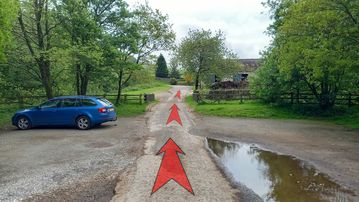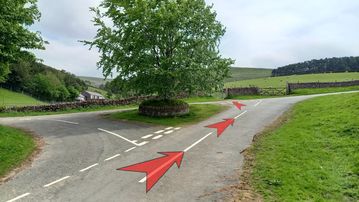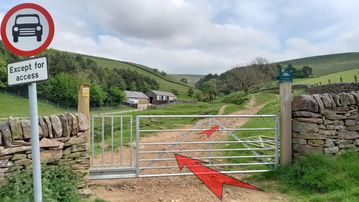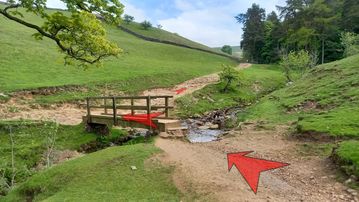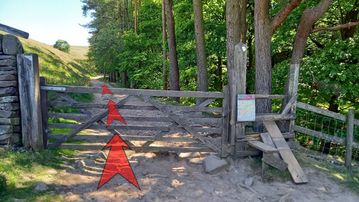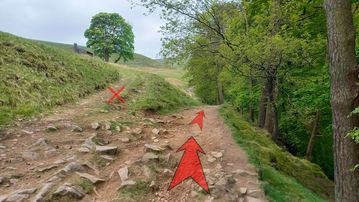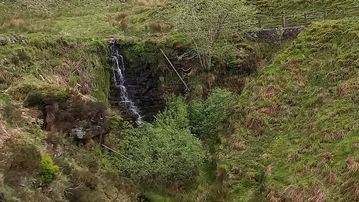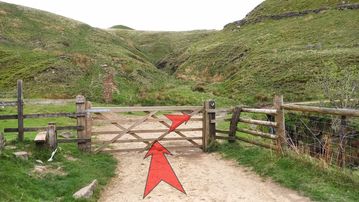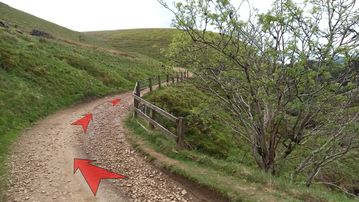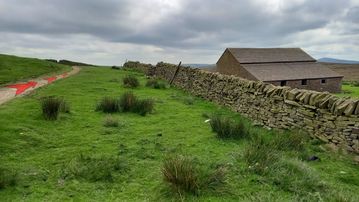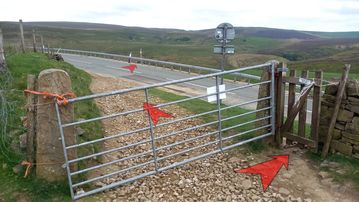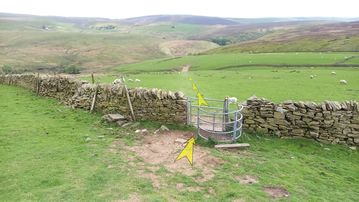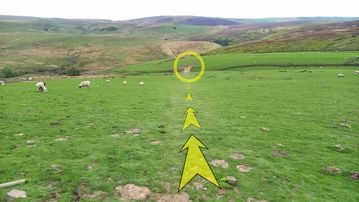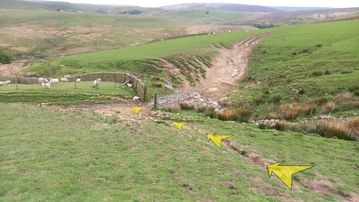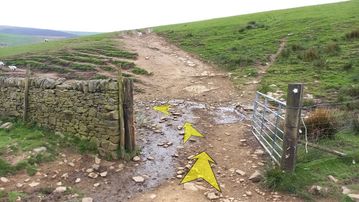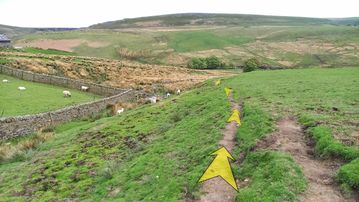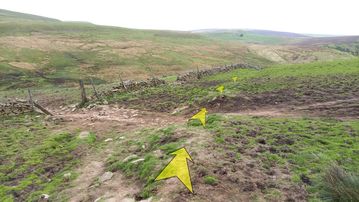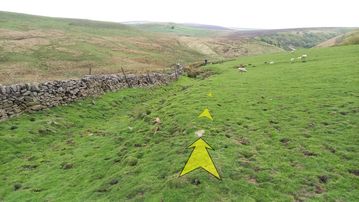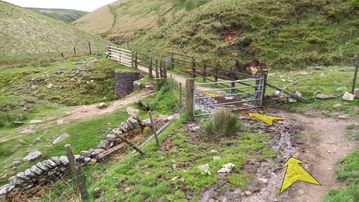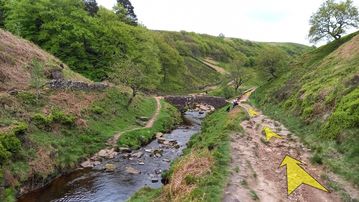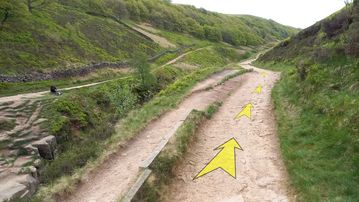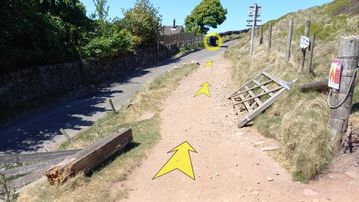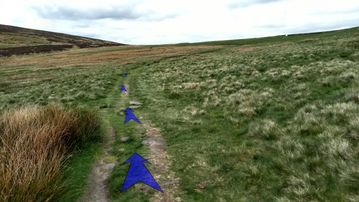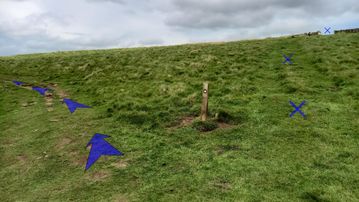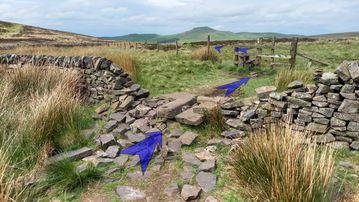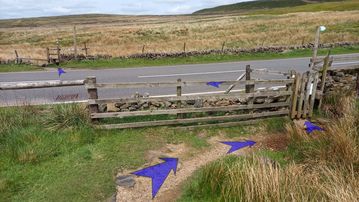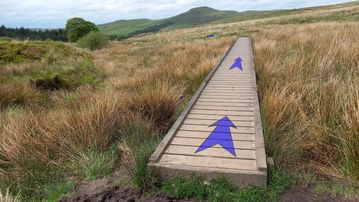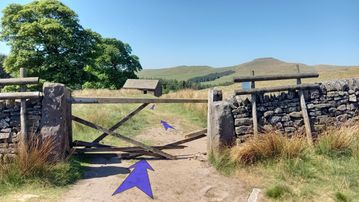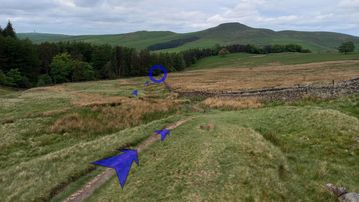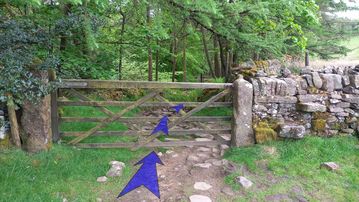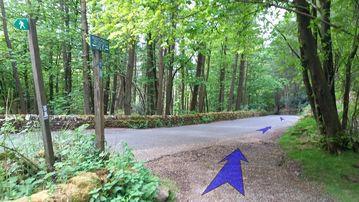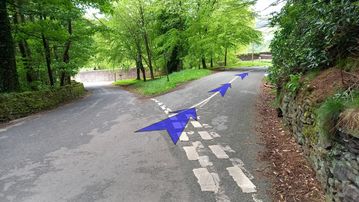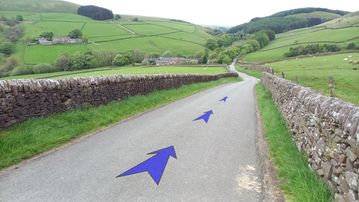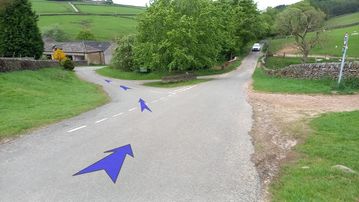Three Shires Head Walk
Visit the beautiful waterfalls at Three Shires Head – the point where Cheshire, Staffordshire and Derbyshire meet
About the walk
This pleasant circuit of a little over 4 miles takes you out to Three Shires Head and back. Taking in secluded river valleys, mature woodland, a couple of miniature waterfalls, open sheep pasture and heather moorland, there are also some gentle hills to stretch the legs nicely – 285 metres (935 feet) ascent and descent in total. Could take as little as 1¼ hours if you don’t hang about, but on a nice day there are plenty of excuses to dally, particularly at the packhorse bridge at Three Shires Head, so allow a good 2 hours, plus extra for a swim and picnic :-)
The route remains within Cheshire throughout, but follows the county boundary with Derbyshire, and then Staffordshire, near Three Shires Head. Technically, you could stand with one foot in Cheshire, one foot in Derbyshire and a hand in Staffordshire, but you’ll get very wet trying…
Need-to-know
- Free parking (car park has three picnic tables, but no toilet facilities; no height restriction; no overnight parking or camping). Sadly, there’s NO PUBLIC TRANSPORT to this location.
- 4½ miles (7¼ kilometres) circular walk.
- Almost 1,000 feet (300 metres) of ascent and descent.
- 2 to 2½ hours at a leisurely pace.
- Mixed terrain (including rough rocky tracks, and boggy ground after rain); not suitable for wheelchair users or for pushchairs. Smaller children may struggle with some of the rougher and muddier terrain.
- 3 stiles (including one ladder stile).
-
Dogs must be kept under effective control (ideally on a short lead) for most of this route, as it uses Public Rights of Way to cross Open Access Land with restrictions in place to protect moorland birds. There are also many fields containing sheep and other livestock. Moorland birds (such as Curlew and Lapwing) are easily disturbed by loose dogs.
You may need to carry your dog down the ladder stile (approx 7 feet tall).
Getting there
Start and finish at Clough House Car Park (arrowed on the following map). The following may help if you use a satnav:
- nearest postcode: SK11 0BD (this postcode is actually in Wildboarclough village, about 1 kilometre south of Clough House Car Park)
- what3words: infinite.firebird.glossed
- Latitude, Longitude: 53.225, -2.020
- Ordnance Survey grid reference: SJ 987 698
Map & directions
This simplified map provides guidance for the route described – the numbers refer to the numbered steps in the walk description. This map is not suitable for detailed navigation, for which you should use a copy of the relevant Ordnance Survey map.
The Ordnance Survey map covers a bigger area along with important information such as place names, official rights of way, and areas of Access Land.
For this walk, the ideal map is the Explorer Series Number OL24: The Peak District - White Peak Area (Buxton, Bakewell, Matlock & Dove Dale), which includes the whole area of the walk at 1:25 000 scale (4 centimetres to 1 kilometre).
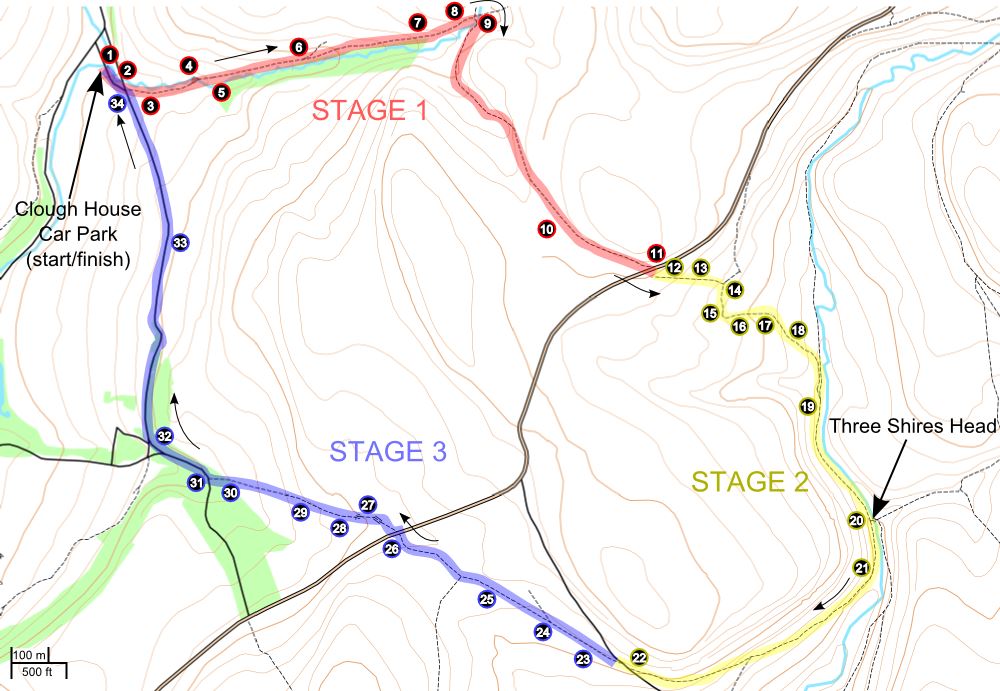
Contour interval: 10 metres; index contours, 50 metres. North at top (approximate).
Map data from OpenStreetMap (available under the Open Database Licence). Contains Ordnance Survey data © Crown copyright & database right 2010–2023.
Base map generated by OpenOrienteeringMap (created by Oliver O'Brien). OpenOrienteering map is supported by British Orienteering.
IMPORTANT It isn't possible to park at or drive to Three Shires Head, which is some distance from a public road. The walk described below starts from one of the closest public car parks (at Clough House, near Wildboarclough).
Stage 1: Clough House Car Park to A54 road
-
Shortly after crossing the footbridge, go through a second gate on the main track.
The stile beside the gate is in a state of disrepair as of May 2025 – however, the gate is not locked, so this shouldn’t pose a problem.
The sign on the stile outlines the restrictions on dogs (these MUST be kept on a short lead, and restricted to the Public Rights of Way as followed by this walk). As of May 2025 the sign is out of date, but the restrictions on dogs continue to apply until October 2029.
Continue on up the main, often rough and rocky track, climbing steadily now with woodland enclosing Cumberland Brook down to your right.
-
Cross the river behind the top of the waterfall, and continue to follow the main track up and around to the right (initially alongside a wooden fence), then gradually back left, all the while climbing across the open hillside.
There are great views from here back down Cumberland Clough and over to Shutlingsloe (the prominent hill).
-
Continue along the main track. This is very stony in places, and is also becoming severely eroded from water run-off.
Pass through a gate across the track and then, still gaining height, pass a stone building (Sparbent) in the field off to your right.
From here, you can see the A54 Buxton to Congleton road (which you will soon cross) and "The Roaches", an obvious hill on the skyline in the direction of Sparbent.
Breeding Curlew and Lapwing are frequent hereabouts from April to July.
-
The track eventually reaches its high point just after Sparbent, and then descends slightly down to the A54.
Go through the wooden gate adjacent to the metal gate, then carefully cross the road and step over the crash barrier on the far side (or walk round the end of the barrier a few metres to the right).
Climb down the ladder stile onto a field.
(Dogs and small children may need assistance descending the ladder stile.)
Stage 2: A54 road to Three Shires Head to minor road
-
Having passed through the kissing gate, the onward route may not be clear (there’s often no visible path across the grassy field).
Continue down hill in the same direction, aiming for the patch of bare ground on the far side of a small gully (circled in the photo).
Continue in this direction until you reach a steepening, where a rough path appears in the grass.
Note that although this route is the most commonly used, it is to the right of the official right of way, which you’ll pick up again at the gully. If signage or temporary fencing indicates a different route to that described here, be sure to follow these local instructions.
These fields are often full of sheep (and lambs during spring/early summer), so if you have a dog, be sure to keep it on a short lead.
-
Continue along the edge of the field (which can get quite muddy), staying fairly close to the wall or fence on the left as you gradually descend towards the River Dane, curving right and reaching a gate after about 200 metres.
The hillside on the far side of the river here is part of Derbyshire, the river marking the border between Derbyshire and Cheshire.
-
Go through the gate (often quite muddy beneath after wet weather), and cross the bridge ahead.
The path is now much narrower, rocky, and fringed with bracken (a lush green in the summer, turning golden brown in the autumn).
After climbing slightly, the path gradually drops down to the confluence of the River Dane with an unnamed tributary (about 400 metres / ¼ mile) where you’ll also see the old packhorse bridge ahead.
-
Welcome to Three Shires Head!
This is the perfect spot for a picnic and a paddle/swim, with grassy banks and rocky outcrops next to the river.
Crossing the main packhorse bridge will take you from Cheshire into Derbyshire, then cross the second (smaller) bridge to pass from Derbyshire into Staffordshire.
There are plenty of photo opportunities too, with the small waterfalls and pools making for a very pretty scene.
When you’re ready to go, be sure to continue along the same path that you arrived on, as there are many paths to different places hereabouts.
-
Continuing along the path that you arrived on (with the River Dane down on your left), follow the path as it gradually climbs and curves right.
The path is slightly wider than previously, but still quite stony and rough underfoot.
There are great views to the left here, over the Dane Valley towards Ramshaw Rocks and The Roaches.
-
Continue along the main path for 1¼ kilometres (¾ mile), climbing gently all the while, until you eventually reach a gateway just before a minor road. (As of May 2025, the gateway here is damaged and the gate not in use.)
Pass through the damaged gateway (a sign on the right points back to Three Shires Head), then cross the minor road diagonally and go through a kissing gate on the far side (circled in the photo).
Stage 3: Minor road to Clough House Car Park
-
Having gone through the kissing gate, follow the grassy path across open ground, which curves to the right and gradually climbs towards the ridge ahead.
The ground here can get quite wet and boggy in places after rain.
You’ve a good chance of hearing and seeing breeding Curlew here from April to July.
These fields are often full of sheep (and lambs during spring/early summer), so if you have a dog, be sure to keep it on a short lead.
-
After about 100 metres, the path reaches the top of the slope and crosses a broken-down stone wall, followed by a fence with a stile (and dog gate).
Shutlingsloe (the obvious hill on the horizon) comes clearly into view here.
Cross the stile, then bear slightly left to continue along the obvious grassy path, heading almost directly towards Shutlingsloe.
About 20 metres after the stile, be sure to bear right, away from the stone wall, to stay on the path that’s heading in the direction of Shutlingsloe. Don’t follow the left-hand path here.
-
Continue along the grassy path (which can get quite wet underfoot after rain), crossing occasional planks over small streams and boggy areas.
The path continues in the direction of Shutlingsloe (roughly northwest) for about 300 metres from the stile, before reaching the A54 Buxton to Congleton road (which you crossed earlier, nearer to Buxton).
Go through a gate to reach the road, then cross the road and go over the stile on the far side.
Take care crossing here; there’s a blind summit to your left, and vehicles often travel quickly on this stretch of road.
-
Having crossed the stile, continue along the well-formed path, first crossing a longer section of boardwalk, then two shorter sections.
Despite the boardwalk, the path in this area can get very wet and boggy after rain.
Continue along the path for about 150 metres from the stile, until you reach a dilapidated gate across the track, just before a small stone building.
-
Go through the gate (the ground approaching the gate can be very boggy), and continue among trees down an exceptionally rough, wet and rocky section of track for about 30 metres, until you meet a minor road.
This short section of track can be quite wet and slippery, even after an extended dry spell.
-
Turn right at the road junction, in the direction indicated by the road sign ("Macc. Forest 2¾"), and keep on the road as you pass the numerous buildings of Crag Hall on your left, and a colourful display of Rhododenrons (from mid-May through June) on the bank to your right.
Continue along the road as it gently climbs through a wooded area for the next 150 metres, then levels out a little after leaving the trees.
